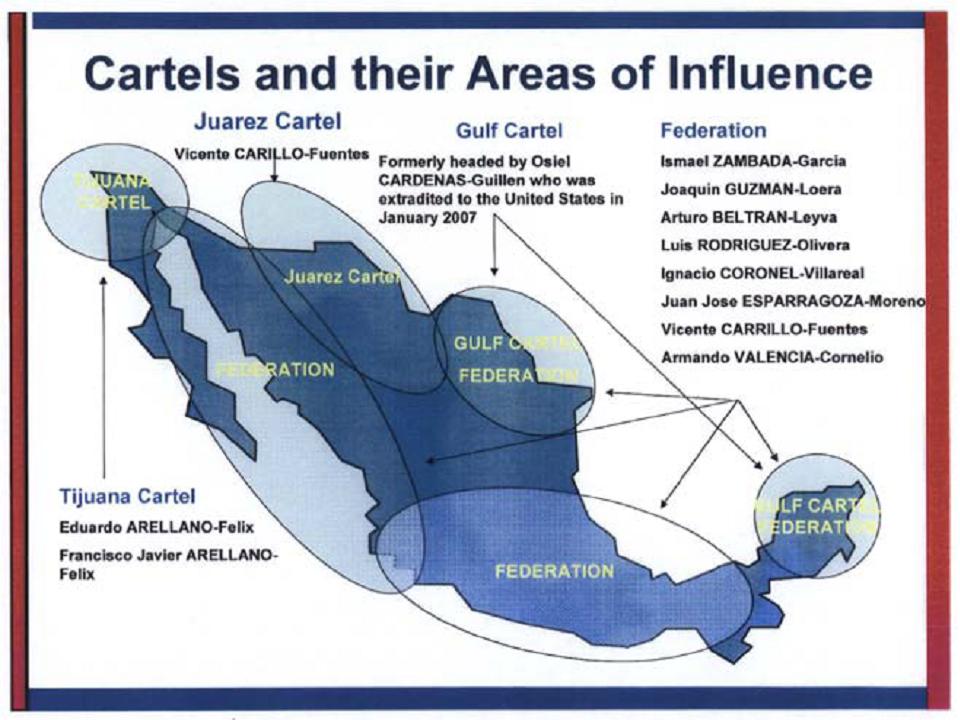|
Golden Crescent
The Golden Crescent is the name given to one of Asia's two principal areas of illicit opium production (with the other being the Golden Triangle). Located at the crossroads of Central, South, and Western Asia, this space covers the mountainous peripheries of Afghanistan and Pakistan, extending into eastern Iran. In 2007, the United Nations Office on Drugs and Crime (UNODC) heroin production estimates for the past 10 years showed significant changes in the primary source areas. In 1991, Afghanistan became the world's primary opium producer, with a yield of 1,782 metric tons (U.S. State Department estimates), surpassing Myanmar, formerly the world leader in opium production. The decrease in heroin production from Myanmar is the result of several years of unfavorable growing conditions and new government policies of forced eradication. Afghan heroin production increased during the same time frame, with a notable decrease in 2001 allegedly as a result of the Taliban's fatwa against ... [...More Info...] [...Related Items...] OR: [Wikipedia] [Google] [Baidu] |
Fatwa
A fatwā ( ; ar, فتوى; plural ''fatāwā'' ) is a legal ruling on a point of Islamic law (''sharia'') given by a qualified '' Faqih'' (Islamic jurist) in response to a question posed by a private individual, judge or government. A jurist issuing fatwas is called a '' mufti'', and the act of issuing fatwas is called ''iftāʾ''. Fatwas have played an important role throughout Islamic history, taking on new forms in the modern era. Resembling ''jus respondendi'' in Roman law and rabbinic ''responsa'', privately issued fatwas historically served to inform Muslim populations about Islam, advise courts on difficult points of Islamic law, and elaborate substantive law. In later times, public and political fatwas were issued to take a stand on doctrinal controversies, legitimize government policies or articulate grievances of the population. During the era of European colonialism, fatwas played a part in mobilizing resistance to foreign domination. Muftis acted as independent ... [...More Info...] [...Related Items...] OR: [Wikipedia] [Google] [Baidu] |
Crime In Pakistan
Crime in Pakistan is present in various forms and occurs everywhere, especially in the many major cities such as Karachi, Lahore, Faisalabad, Rawalpindi, Gujranwala, Peshawar, Multan, Hyderabad, Islamabad and Quetta. Among other general crimes, it includes major crimes such as murder, rape, gang rape, sexual abuse of a minor, kidnapping, armed robbery, burglary and carjacking. For example, in the city of Lahore 379 murders, 500 attempted murders, 2,650 abductions and 55 rapes have occurred in 2019. Organised crime Organised crime in Pakistan includes fraud, racketeering, drug trafficking, smuggling, money laundering, extortion, ransom, political violence, etc. Terrorist attacks became common during the 2000s, especially in North-West Frontier Province, the Federally Administered Tribal Areas, Balochistan, Karachi and Lahore. Vehicle theft is common, particularly in the large cities. Opium production Pakistan falls under the Golden Crescent, which is one of the two maj ... [...More Info...] [...Related Items...] OR: [Wikipedia] [Google] [Baidu] |
Opium In Iran
Opium in Iran is widely available, and the country has been estimated to have the highest per capita number of opioid addicts in the world at a rate of 2.8% of Iranians over age 15. The Iranian government estimates the number of addicts at 2 million. Opium and heroin from Afghanistan and Pakistan—known collectively as the Golden Crescent—pass through Iran's eastern borders in large amounts. Extent Total annual opium intercepts by the Iranian authorities are larger than in any other country. The Iranian government admits that they can only intercept a tiny proportion of the thousands of tonnes that are trafficked through Iran every year. Opium costs far less in Iran than in the West, and is cheaper than beer. In Zahedan, an Iranian town near the Pakistani border, 3 grams of opium can be purchased for 10,000 Iranian rials, equivalent to less than ~$0.25 USD (based on an exchange rate of 42,000 IRR = $1 USD), and 1 kg costs the equivalent of ~$85. In Zabol, $1 buys ... [...More Info...] [...Related Items...] OR: [Wikipedia] [Google] [Baidu] |
Drug Cartel
A drug cartel is any criminal organization with the intention of supplying drug trafficking operations. They range from loosely managed agreements among various drug traffickers to formalized commercial enterprises. The term was applied when the largest trafficking organizations reached an agreement to coordinate the production and distribution. The term is used to refer to any criminal narcotics related organization. The basic structure of a drug cartel is as follows: * Falcons (Spanish: ''Halcones''): Considered as the "eyes and ears" of the streets, the "falcons" are the lowest rank in any drug cartel. They are responsible for supervising and reporting the activities of the police, the military and rival groups. * Hitmen (Spanish: ''Sicarios''): The armed group within the drug cartel, responsible for carrying out assassinations, kidnappings, thefts and extortions, operating protection rackets, as well as defending their ''plaza'' (turf) from rival groups and the military. * ... [...More Info...] [...Related Items...] OR: [Wikipedia] [Google] [Baidu] |
Xinjiang
Xinjiang, SASM/GNC: ''Xinjang''; zh, c=, p=Xīnjiāng; formerly romanized as Sinkiang (, ), officially the Xinjiang Uygur Autonomous Region (XUAR), is an autonomous region of the People's Republic of China (PRC), located in the northwest of the country at the crossroads of Central Asia and East Asia. Being the largest province-level division of China by area and the 8th-largest country subdivision in the world, Xinjiang spans over and has about 25 million inhabitants. Xinjiang borders the countries of Mongolia, Russia, Kazakhstan, Kyrgyzstan, Tajikistan, Afghanistan, Pakistan and India. The rugged Karakoram, Kunlun and Tian Shan mountain ranges occupy much of Xinjiang's borders, as well as its western and southern regions. The Aksai Chin and Trans-Karakoram Tract regions, both administered by China, are claimed by India. Xinjiang also borders the Tibet Autonomous Region and the provinces of Gansu and Qinghai. The most well-known route of the historic Silk Ro ... [...More Info...] [...Related Items...] OR: [Wikipedia] [Google] [Baidu] |



